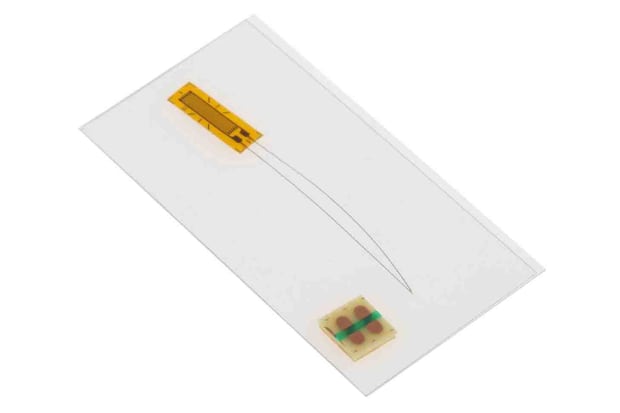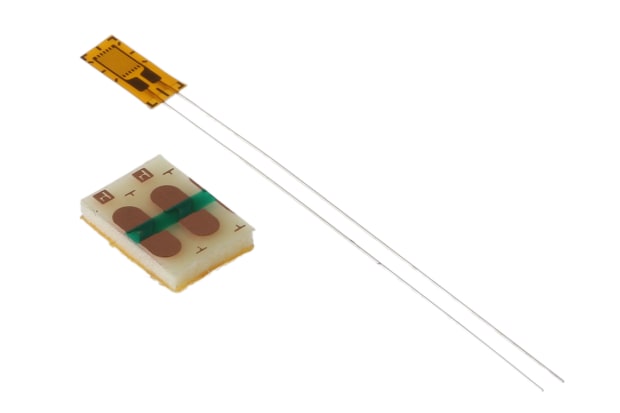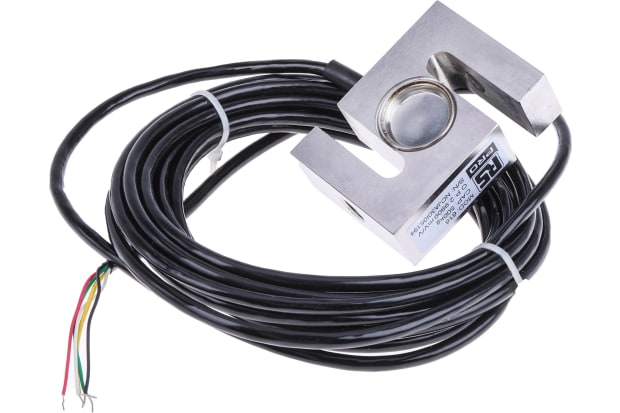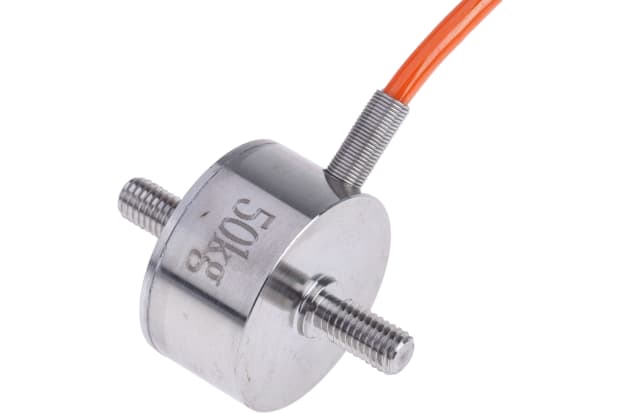- Published 24 Jan 2023
- Last Modified 29 Aug 2023
- 11 min
A Guide to Strain Gauges
Our guide looks at strain gauges and load cells, explaining how you can use them to measure strain.

A strain gauge (or, less commonly, strain gage) is a widely used sensor tool for measuring stress forces in an object or material under load.
By showing how strain and fatigue forces are impacting a physical material, strain gauges enable engineers to make various key decisions about all kinds of designs, builds and installations.
Strain gauges are a well-established method of monitoring material performance, having been in use since the mid-1900s. They can be used as standalone sensor devices or connected in series to form a Wheatstone bridge, for accurate measuring of unknown resistances and differences. They can also be used in a load cell configuration for various industrial applications, including precision weighing or long-term monitoring of strain, material impact and performance.
In this introductory guide, we will learn all the key basics about strain gauges. This will include exactly what they do and how they work, as well as how they help to optimise overall productivity and build quality across various types of industry.
We will also explain how to position and use a strain gauge, as well as provide a clear idea of how to shop for strain gauges online in the UK.
Definition of a Strain Gauge
What are strain gauges? To answer this question, you need to understand the basic strain gauge principles. This includes understanding what do strain gauges measure and how do strain gauges work.
First and foremost, though, it is important to understand a clear strain gauge definition. For this guide, we will define strain gauges as follows:

A strain gauge, or strain gage, is a type of sensor device. It measures stress and fatigue forces in materials it is directly attached to using the properties of electrical conductance.
Strain gauges and load cells are types of transducers, meaning they convert one form of energy into another. Specifically, strain gauges convert physical loads or stresses - pressure, torque, tension and compression - into a readable electrical signal. This is often used in weighing applications.
This signal is expressed via a sensor as a real-time resistance change, caused by physical displacement (deflection or deforming) of the active gauge. The way it changes over time will reflect the ongoing physical impact of those stress forces on the materials or objects being monitored.
The most common format for a strain gauge sensor is a wide strip of flexible backing material containing an embedded conductive element - usually a series of wire leads or foil traces. The low-profile elastic strip is mounted and bonded directly to the surface of the object or material being measured, using a suitable industrial adhesive.
Once in place, passing a voltage or current through the sensor device allows engineers to take electronic readings from the strain gauge circuit. The changes in resistance observed will show how load or strain forces are impacting the material in question over time. Both positive (stretch) and negative (compression) strain forces are measurable in this way.
Where are Strain Gauges Used?
So, what are strain gauges used for? The short answer is that they are used in every aspect of material engineering. Strain gauges can be used to give a clearer idea of how a material is behaving under load in any design or build where physical stress analysis is an important factor.
Common examples of industries and projects where strain gauge technology is widely used include:
- Automotive, marine and aerospace design
- Building and architecture, including bridge, weighbridges and tunnel construction
- Industrial engineering and weighing
- Long-term monitoring of material performance e.g. S-beam tensile strain
- Geotechnical installations such as power plants and refineries
- Torque measurement in motors, turbines, engines, fans, generators, wheels, and propellers
- Transducer and load cell manufacture
- Experimental stress analysis
Like strain gauges, load cells are also widely used in all kinds of industrial settings, especially as a cost-effective solution for high precision weighing applications.
How Do Strain Gauges Work?

In understanding how strain gauges work, it is key to have a basic grasp of the main working principle of a strain gauge. Because they are electrically conductive, the resistance of a flexible strain sensor will always alter slightly as their shape and surface area change.
Strain gauges are normally attached directly to the object or surface they are measuring and are designed to allow for the bending of their materials. As load-bearing or stress forces slightly change the shape of the underlying material, this means that the strain gauge also changes shape along with it. This, in turn, alters the resistance of the wire or foil circuit embedded in the strain gauge, which can be read and interpreted by the user passing voltage through it. Note that non-contact strain measurement is also possible but requires the use of digital imaging correlation (DIC).
Reading a strain measurement involves using the basic principle for electrical resistance: R = L/A. In this common strain gauge equation, R is the resistance, L is the length of the conductor, and A is its cross-sectional area. In other words, we can use a derivative of Ohm’s Law to chart changes in electrical resistivity caused by flex in the strain gauge material.
This will also be reflective of changes in the physical shape and position of the surface or object where it is bonded. In even simpler terms, compression forces will shorten the circuit formed by the strain gauge traces, causing resistance to drop. Similarly, stretching forces will elongate the circuit, causing overall resistance to increase.
Various types of forces acting on the sensor material (such as pressure, tension and weight) will affect its physical shape and position in some way, typically causing bending. These changes can then be measured directly from the strain gauge as fluctuations in electrical resistance. Strain gauge instrumentation and operation is not overly complex, although you should familiarise yourself with the key terms.
These include:
- Apparent strain: an output signal caused by the effects of temperature change (thermal output) in the object being tested, and not due to the actual mechanical load
- Wheatstone bridges: an arrangement of multiple strain gauges, including a so-called dummy gauge, often used to compensate for this
- Bridge factor or gauge factor: the number (1-4) of active strain gauges used in a Wheatstone bridge circuit
- Strain: a measurement of physical change in the length of a material, relative to its starting length. The symbol for representing mechanical strain is ε
- Stress: in mathematical terms, the material stress factor is arrived at by calculating force (F) divided by the cross-sectional area (A). The symbol for representing mechanical stress is σ, so σ = F/A
- Residual stress: also called inherent stress, this can be caused by various internal factors in the material itself, rather than applied directly as an external force. Examples include manufacturing inconsistencies or natural fluctuations in density, as well as internal compression or strain caused by the material’s weight. Residual stresses are also considered in most engineering applications, but it is important to be aware of the different causes of material strain
- Bridge excitation voltage: because a strain gauge sensor is effectively a type of electrical resistor, it will naturally convert the voltage to heat when connected and switched on. Since output voltage heat will also affect resistance (and therefore change the readings), the strain gauge must not be allowed to warm up excessively during use. For this reason, strain gauges will always come with a maximum rating for bridge excitation voltage. This denotes the upper limit of electrical power that can be supplied to the device for accurate operation
How Do Load Cells and Strain Gauges Relate?

Much like a strain gauge, a loadcell is also a type of electrical transducer that converts force changes into an electrical output signal. There are various types of load cells available, but the one most commonly used in industrial settings is made up of four strain gauges linked in sequence.
As with a single strain sensor, strain gauge load cells can be used to measure positive or negative values for tensile (positive), torsion or compression (negative) stress forces. In other words, they can measure both material expansion and contraction.
Load cells are commonplace measurement tools in industrial weighing applications. They might often be found as part of safety-critical electrical systems, particularly when arranged as pneumatic load cells or hydraulic load cells. Proper load cell wiring and load cell calibration will depend on the specific type being used. For most industrial weighing tasks, strain gauge load cells will be the preferred arrangement.
Typically, a strain gauge load cell of this type will consist of four strain gauges, two held in tension and two in compression. This arrangement tends to offer optimal sensitivity and temperature compensation, with extremely high accuracy achievable at relatively low individual unit costs.
Different Types of Strain Gauges
There is a wide range of strain gauge types available online in the UK. These range from wire strain gauges to foil strain gauges, linear strain gauges (similar in core principle to a linear variable differential transformer, or LVDT), half-bridge and full-bridge strain gauges, compression load cells, beam load cells, force sensors, and multiple other variants.
Choosing the right type of device for the strain gauge applications you are tackling is key. Doing so will always give you the best strain gauge performance in terms of optimal accuracy and reliability. When choosing between different types of strain gauges for a defined purpose, there will always be several important considerations to bear in mind.
Firstly, you will need to be clear on what specific type of strain force you are measuring (mass, torque/torsional, axial strain, pressure, compressive, bi-directional, material fatigue, shear etc). You will also need to know what type of durability test you will be running. This could include experimental stress analysis, residual stress analysis, microstrain, deformation, material longevity/lifetime analysis, load analysis, thermal stress, temperature effects, or various others.
Based on your answers to the above, you will then have to decide between numerous models and types of strain gauges based on their main physical properties. These include:
- Strain gauge geometry - this is the number of tracer grids a given device includes, how they are arranged, and the resulting active grid length
- Strain gauge series and connections - how the device is physically constructed and laid out, and if/how it is connected in sequence with others e.g. wire gauge lengths
- Device electrical resistance - measured in Ohms
- Material temperature response, performance and adaptation - the type of gauge you choose will need to be matched to the thermal characteristics of the material and install location you are monitoring

Each type and model of device will have a slightly different set of characteristics in terms of overall physical size (length), sensitivity, range, and strain gauge accuracy. Common types of electrical strain gauge found in many everyday engineering and analysis projects include:
- Wire strain gauge
- Foil strain gauge
- Quarter bridge strain gauge
- Full bridge strain gauge
- Linear and double linear strain gauges
- T-rosette gauge
- V-shape strain gauge
- Strain gauge chains
- Integrated solder tab gauges
- Copper lead gauges
- Bolt strain gauges
- Hermetically sealed strain gauge
- Embedded strain gauge
How to Use a Strain Gauge
Once you understand the basic strain gauge principle, it is relatively easy to figure out how to use a strain gauge. The trickier part is learning how to position a strain gauge for the best and most accurate results.
Knowing exactly how to position strain gauges for optimal measurement results can be fairly involved, and results will always benefit from a good amount of user experience. However, it is possible to learn proper positioning - as well as how to measure strain gauges accurately - in a fairly short time.
A crucially important part of proper strain gauge use is learning to prepare the material being measured. It is vital to do this using the correct procedure before installing the strain measurement device. There are various approaches - knowing which to use will depend on the type of material being tested, strain gauge type, and the exact form of stress monitoring being done.
For example, concrete will need to be prepared and cleaned differently from wood, plastics, fibre-reinforced plastic, rubber, and glass. Some surfaces will need to be sanded smoother, others will need to be slightly roughened. Even the type of cleaning solution you use will differ based on the material in question. Cleanliness is key to achieving proper adhesion and reliable results.
It is equally important to choose the right adhesive for the material where the strain gauge will be attached. Some glues are much more suitable for porous surfaces (i.e. they have a strong pore-filling quality), while others will need to be better at coping with smooth and hard surfaces, rapid temperature changes, environmental challenges, certain types of cleaning solvents, and so on.